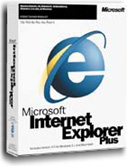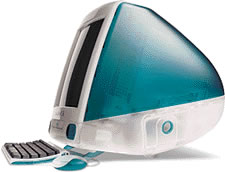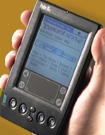click on the home button to go to the home page
|
The Industrial Era 1996 -1999 Internet came of age. And companies like Microsoft, AOL and Prodigy, were entering the internet market Multi Media machines and digital camera's became affordable for the average consumer For this period counts the same as the previous chapter: |
pre history | antiquity | pre industrial era | industrial era
1947
- 1950 - 1952 - 1955
- 1958 - 1961 - 1963
- 1965 - 1969 - 1970
- 1972 - 1974 - 1976
1978 - 1980 -
1981 - 1982 - 1984 - 1986
- 1989 - 1991 - 1993
- 1994 - 1996
- 2000 - 2002
| Related Articles |
| Related Resources |
![]() Corel purchase
WordPerfect, Quattro Pro, and the PerfectOffice application suite from Novell
for US$180 million in cash, stock, and future licensing royalties.
Corel purchase
WordPerfect, Quattro Pro, and the PerfectOffice application suite from Novell
for US$180 million in cash, stock, and future licensing royalties.
![]() Intel introduces
the 200 MHz Pentium processor, shipping it initially in small quantities. It
incorporated 3.3 million transistors, and performed at 284 MIPS. Price was US$599
in quantities of 1000.
Intel introduces
the 200 MHz Pentium processor, shipping it initially in small quantities. It
incorporated 3.3 million transistors, and performed at 284 MIPS. Price was US$599
in quantities of 1000.
![]() Microsoft releases
Windows NT 4.0. Microsoft also unveils Windows CE operating system for hand-held
PCs. Code-name of the project was Pegasus. "CE" stood for Consumer
Electronics.
Microsoft releases
Windows NT 4.0. Microsoft also unveils Windows CE operating system for hand-held
PCs. Code-name of the project was Pegasus. "CE" stood for Consumer
Electronics.
![]() The first
successful and affordable Personal Digital Assistants (PDA) the Palm Pilot becomes
available to consumers, with memory large enough to hold thousands of contacts,
appointments and notes. PDA's can do calculations, play games and music and
potentially download information from the Internet. Since the interface was
very easy to use it becomes an in mediate hit with consumers. It is small and
light enough to fit in a shirt pocket and runs for weeks on a few AAA batteries.(4)
The first
successful and affordable Personal Digital Assistants (PDA) the Palm Pilot becomes
available to consumers, with memory large enough to hold thousands of contacts,
appointments and notes. PDA's can do calculations, play games and music and
potentially download information from the Internet. Since the interface was
very easy to use it becomes an in mediate hit with consumers. It is small and
light enough to fit in a shirt pocket and runs for weeks on a few AAA batteries.(4)
![]() IBM launches
OS/2 Warp 4, in San Francisco, California. Price was US$249.
IBM launches
OS/2 Warp 4, in San Francisco, California. Price was US$249.
![]() CD-ReWritable
(CD-RW) is announced. The technology is developed by a five-company consortium.
CD-ReWritable
(CD-RW) is announced. The technology is developed by a five-company consortium.
![]() Apple Computer
buys the NeXT Software company for about US$425 million in cash and Apple stock.
Apple Computer
buys the NeXT Software company for about US$425 million in cash and Apple stock.
![]() One of the
first web shops is opened by IBM: World Avenue. IBM calls it a "Web shopping
mall" that allows online vendors to rent virtual storefronts. This is one
of the earliest examples of commercial site hosting. However, the online mall
concept fails to catch on, and IBM will close World Avenue a year later. (10)
One of the
first web shops is opened by IBM: World Avenue. IBM calls it a "Web shopping
mall" that allows online vendors to rent virtual storefronts. This is one
of the earliest examples of commercial site hosting. However, the online mall
concept fails to catch on, and IBM will close World Avenue a year later. (10)
![]() The New York
Times , which previously offered its content through America Online, announce
that it has launched its own web site. The first paper to do so.
The New York
Times , which previously offered its content through America Online, announce
that it has launched its own web site. The first paper to do so.
As consumers move from proprietary services like AOL to the Web throughout late
1995 and 1996, proprietary services begin to lose customers, and many publishers
start to migrate their content to the Web. (10)
![]() January. General
Electric (GE) sells its Genie online service. GE was one of many corporations
that tried to enter the online service game in the early 1990s. However, the
rise of the web draws customers away from online services, and many ventures,
like Genie, are sold and turned into Internet Service Providers (ISP). (10)
January. General
Electric (GE) sells its Genie online service. GE was one of many corporations
that tried to enter the online service game in the early 1990s. However, the
rise of the web draws customers away from online services, and many ventures,
like Genie, are sold and turned into Internet Service Providers (ISP). (10)
![]() February. Pointcast,
a little-known company in Cupertino, California, announces a beta version of
its Pointcast software. The service, which grabs information from the Web to
display it on the user's screen, kicks off a year of industry hype about "push"
technologies. The hype fades after a year or so when consumers fail to embrace
push-technology over active web browsing. (10) Push technology
will evolve into the annoying pop-up windows a few years later. On its turn
triggering a tug of war between the advertisers and the commercial defenders.
Anti pop-up utilities will be a standard feature of most browsers in about 6
years.
February. Pointcast,
a little-known company in Cupertino, California, announces a beta version of
its Pointcast software. The service, which grabs information from the Web to
display it on the user's screen, kicks off a year of industry hype about "push"
technologies. The hype fades after a year or so when consumers fail to embrace
push-technology over active web browsing. (10) Push technology
will evolve into the annoying pop-up windows a few years later. On its turn
triggering a tug of war between the advertisers and the commercial defenders.
Anti pop-up utilities will be a standard feature of most browsers in about 6
years.
![]() In March and
April, Lycos, Excite, and Yahoo, al search engines went public. All will perform
strongly. (10)
In March and
April, Lycos, Excite, and Yahoo, al search engines went public. All will perform
strongly. (10)
 |
|
The way Microsoft pushes this browser, e.g. by integrating this into the MS Window software, will in about 8 years result to that some 96% of all web users use Internet Explorer. Some courts will rule that this practice is crossing the line of legal competitive commercial behavior and deems that Microsoft must separate Internet Explorer from their Windows operating system. It will take years of legal battle and counter attacks before Microsoft will comply. However practice will neutralize the court's decision, by enabling to disable IE as a standard browser. And it seems that the US legal system is forgetting what it started with. |
 |
![]() October. Prodigy, once one of
the top three online service providers, re launched itself as an Internet access
provider. Sears and IBM have launched the joint venture in the late 1980s but
sold it in 1996 as online service customers migrated to the web. Although Prodigy
continues to provide a proprietary online service, the company's management
says that Internet access will become the company's main focus. Prodigy will
go public in 1998. (10)
October. Prodigy, once one of
the top three online service providers, re launched itself as an Internet access
provider. Sears and IBM have launched the joint venture in the late 1980s but
sold it in 1996 as online service customers migrated to the web. Although Prodigy
continues to provide a proprietary online service, the company's management
says that Internet access will become the company's main focus. Prodigy will
go public in 1998. (10)
![]() Bluetooth
technology is invented by Dutchman J. Haaften employed by Ericsson (Sweden).
In about 2 years time this technology will be adapted as an industry standard
because Ericsson has put the technology in the public domain as an open architecture.
The latter is also one of the main reasons why the PC technology is flying high
since the mid eighties. Bluetooth is suitable to be built into many appliances,
but was developed for the mobile telephony.
Bluetooth
technology is invented by Dutchman J. Haaften employed by Ericsson (Sweden).
In about 2 years time this technology will be adapted as an industry standard
because Ericsson has put the technology in the public domain as an open architecture.
The latter is also one of the main reasons why the PC technology is flying high
since the mid eighties. Bluetooth is suitable to be built into many appliances,
but was developed for the mobile telephony.
![]() In
this year IBM releases Deep Blue
In
this year IBM releases Deep Blue
A super computer tailored to beat a world champion chess player: Garry Kasparov.
The machine performs at a trillion Flops. But many critics are saying that it
has only beaten Kasparov by brute force and had little to do with AI. Fact is
that it is the most powerful computer for this year.
![]() Apple
co-founder Steve Jobs, who left the company in 1985 to found Next Software and
later become president of Pixar, returns to Apple as interim CEO. Two years
later, he will still be in the "interim" position.
Apple
co-founder Steve Jobs, who left the company in 1985 to found Next Software and
later become president of Pixar, returns to Apple as interim CEO. Two years
later, he will still be in the "interim" position.
![]() Sun
files a lawsuit against Microsoft, accusing the software giant of undermining
Sun's Java programming language. Sun alleges that Microsoft is trying to disrupt
Java development by distributing a version of Java not compatible with that
used by the rest of the industry. (10)
Sun
files a lawsuit against Microsoft, accusing the software giant of undermining
Sun's Java programming language. Sun alleges that Microsoft is trying to disrupt
Java development by distributing a version of Java not compatible with that
used by the rest of the industry. (10)
![]() Amazon.com,
an online bookseller, goes public in May. The day before the IPO, Barnes and
Noble sues Amazon for allegedly falsely advertising itself as "the world's
largest bookstore." Nevertheless, the online bookseller closes 30 percent
above its opening price. The lawsuit will be settled later this year.
Amazon.com,
an online bookseller, goes public in May. The day before the IPO, Barnes and
Noble sues Amazon for allegedly falsely advertising itself as "the world's
largest bookstore." Nevertheless, the online bookseller closes 30 percent
above its opening price. The lawsuit will be settled later this year.
![]() America Online
buys its onetime rival, CompuServe. Rather than merging it into its own online
offerings, AOL leaves CompuServe as a separate service. (10)
America Online
buys its onetime rival, CompuServe. Rather than merging it into its own online
offerings, AOL leaves CompuServe as a separate service. (10)
![]() April. Microsoft
buys Web TV Networks. The company's technology allows users to read e-mail and
surf the Web on their television sets. The $425 million purchase is Microsoft's
largest Internet-related acquisition to date. (10)
April. Microsoft
buys Web TV Networks. The company's technology allows users to read e-mail and
surf the Web on their television sets. The $425 million purchase is Microsoft's
largest Internet-related acquisition to date. (10)
![]() June. The USA
Supreme Court rejects the Communications Decency Act. Part of the Telecommunications
Act of 1996, the act makes it a felony to distribute "indecent material"
on the Internet. The court unanimously rules that the law violates the First
Amendment: freedom of information. (10)
June. The USA
Supreme Court rejects the Communications Decency Act. Part of the Telecommunications
Act of 1996, the act makes it a felony to distribute "indecent material"
on the Internet. The court unanimously rules that the law violates the First
Amendment: freedom of information. (10)
![]() The Frauenhofer
Institute (Germany) releases the MP3 format, even when the Institute patents
the format there will be no royalties asked for its use, a influential stimulant
to make it the PC's core, and many more appliances, music system.
The Frauenhofer
Institute (Germany) releases the MP3 format, even when the Institute patents
the format there will be no royalties asked for its use, a influential stimulant
to make it the PC's core, and many more appliances, music system.

![]() The
first affordable digital cameras come on the market, the number of brands and
models are increasing by the day
The
first affordable digital cameras come on the market, the number of brands and
models are increasing by the day

They are at first very simple camera's with mainly USB ports and special cables or equipped with memory cards or modules. The quality (480 x 640) and saturation is very poor. But the next year better cameras will see the light. But for simple web publishing this kind of digital cameras are all right. An attempt to construct a digital replacement for the normal 35mm picture cartridge is tampered by low resolution, high energy consumption and price (over 1000 US$). Another development of digital photography is an inlay that can be placed inside the mirror reflex cameras. It means a second life for those reflex cameras gathering dust But it still is an expensive gadget not for the normal photo amateur. The next few years will show dramatic improvements both in quality and price.


left iMac from August 1998(11)
right Apple eMac from April 2002
![]() August.
Apple Inc. releases the iMac. A machine intended for starters
and according to Apple it is optimized for the Internet. It's not a machine
more advanced then other brands but it starts a totally new trend in computer
styling and marketing.
August.
Apple Inc. releases the iMac. A machine intended for starters
and according to Apple it is optimized for the Internet. It's not a machine
more advanced then other brands but it starts a totally new trend in computer
styling and marketing.
The machine has a semi transparent colored casing and looks like a modernized
terminal from the 80's, everything is build into one single box.
It is the first PC, in this decade, devoid of "legacy I/O
technology". The lack of a floppy drive, and total reliance on USB connectors,
instead of serial/parallel/ADB(6). This considered very risky
by industry pundits. Yet it fuels USB (universal serial
bus) device development, and pushes the adoption of USB by
PC manufacturers. PC manufacturers start struggling to develop a truly "legacy-free"
PC in the vein of Apple's original iMac.(5)
In terms of corporate survival however this new marketing strategy is also saving
Apple Inc. from going under. The next few years Apple will go through a complete
revival.
 |
Speculations pointed towards the creation of unlimited memory with this technology, consuming virtually no power.(8)
|
 |
|

![]() Auction
site eBay, started as a location where founder Pierre Omidyar's girlfriend could
swap Pez dispensers with other collectors, launched a spectacular IPO. The company's
stock price soared 163 percent on its first day of trading. (10)
Auction
site eBay, started as a location where founder Pierre Omidyar's girlfriend could
swap Pez dispensers with other collectors, launched a spectacular IPO. The company's
stock price soared 163 percent on its first day of trading. (10)
![]() The
U.S. government decided to privatize the registration of Internet addresses
called: URL's (Uniform Resouce Locators). Government contractor Network
Solutions had enjoyed an exclusive government contract during the last six years,
registering some two million names at seventy dollars apiece. The government
created the Internet Corporation for Assigned Numbers and Names (ICANN) to help
privatize the business. (10)
The
U.S. government decided to privatize the registration of Internet addresses
called: URL's (Uniform Resouce Locators). Government contractor Network
Solutions had enjoyed an exclusive government contract during the last six years,
registering some two million names at seventy dollars apiece. The government
created the Internet Corporation for Assigned Numbers and Names (ICANN) to help
privatize the business. (10)
![]() October. The
Justice Department's long-awaited antitrust suit against Microsoft Inc. was
launched. The government alleged that Microsoft engaged in predatory and anti-competitive
business practices regarding its operating system. The case dragged on for several
years. (10)
October. The
Justice Department's long-awaited antitrust suit against Microsoft Inc. was
launched. The government alleged that Microsoft engaged in predatory and anti-competitive
business practices regarding its operating system. The case dragged on for several
years. (10)
![]() October. President
Bill Clinton (USA) signed the Digital Millennium Copyright Act, a law that imposed
new safeguards for copyrighted materials on the Internet. The legislation also
barred technologies that can crack copyright protection devices. (10)
October. President
Bill Clinton (USA) signed the Digital Millennium Copyright Act, a law that imposed
new safeguards for copyrighted materials on the Internet. The legislation also
barred technologies that can crack copyright protection devices. (10)
![]() November. America
Online (AOL) bought Netscape rocking the online world. Some industry analysts
say the move will make AOL powerful enough to challenge Microsoft's dominance
in the technology industry. (10)
November. America
Online (AOL) bought Netscape rocking the online world. Some industry analysts
say the move will make AOL powerful enough to challenge Microsoft's dominance
in the technology industry. (10)
![]() Google
is founded by Larry Page and Sergey Brin, two Stanford Ph.D. candidates, who
developed a technologically advanced method for finding information on the Internet.
Google is a play on the word googol
meaning "an unspeakable large number". Google's use of the term reflects
the company's mission to organize the immense amount of information available
on the web.(2)
Google
is founded by Larry Page and Sergey Brin, two Stanford Ph.D. candidates, who
developed a technologically advanced method for finding information on the Internet.
Google is a play on the word googol
meaning "an unspeakable large number". Google's use of the term reflects
the company's mission to organize the immense amount of information available
on the web.(2)

![]() On
February 10, ICL (Electrolux) brought out their version of the Kitchen
Computer. A Web/Java based application integrated in a refrigerator.
On
February 10, ICL (Electrolux) brought out their version of the Kitchen
Computer. A Web/Java based application integrated in a refrigerator.
Honeywell that tried to introduce a similar device in 1969 had to abandon the
project.
ICL was one of the first to try it again 30 years later. Time will prove whether
this machine is too early again. (see also Honeywell 1969)
picture ICL

![]() Palmtop
computers with color displays com within reach of the average consumers. Prices
will go down to less than 200 US$ for palmtops with about the same features.
In the next five or six years palmtops (later called PDA's) will become more
and more complex and the price will rise to about 500 USD including features
like bluetooth, gps, mpeg player, movies and telephony
Palmtop
computers with color displays com within reach of the average consumers. Prices
will go down to less than 200 US$ for palmtops with about the same features.
In the next five or six years palmtops (later called PDA's) will become more
and more complex and the price will rise to about 500 USD including features
like bluetooth, gps, mpeg player, movies and telephony
picture: www.pcmagazine Feb 2000
![]() The
Millennium bug is taken seriously
now by almost al industrialized countries. Those who are willing to spent the
money fix most of the errors found in programs that were related to calculations
with dates and codes that could relate to leap years and the so called signal
codes (99 meant often end of record or file).
The
Millennium bug is taken seriously
now by almost al industrialized countries. Those who are willing to spent the
money fix most of the errors found in programs that were related to calculations
with dates and codes that could relate to leap years and the so called signal
codes (99 meant often end of record or file).
The main advantage however of these actions are that the firms and governmental
organizations that take action on the millennium issue now have an big advantage
on their competitors. They clean out all old programs, some times modernize
them and throw out the stuff where functionality can be taken over by more modern
programs or hardware. They can now make a fresh start.
![]() The
plummeting price of PCs leads some companies to offer free or very cheap PCs
if users sign up for online services. One company, Free-PC.com, distributes
free computers to people who agree to share personal information and download
Internet advertising.
The
plummeting price of PCs leads some companies to offer free or very cheap PCs
if users sign up for online services. One company, Free-PC.com, distributes
free computers to people who agree to share personal information and download
Internet advertising.
Disney and Infoseek launch the Go Network (January)
Disney and Infoseek create the Go Network and launch an aggressive advertising
campaign to drive traffic to the site. In July, Disney buys a majority stake
in Infoseek. (10)
![]() Prodigy Classic online service
folds (January)
Prodigy Classic online service
folds (January)
Citing Y2K computer problems, Prodigy announces it will shut down its Prodigy
Classic online service. The company had focused on its Internet service provider
business for several years, but maintained the online service, which still had
about 208,000 customers. (10)
![]() Gates increases philanthropic
efforts (August)
Gates increases philanthropic
efforts (August)
Bill Gates merges his two charitable foundations, the William H. Gates Foundation
and the Gates Learning Foundation, into one organization, the Bill and Melinda
Gates Foundation. The merger created the country's richest charitable foundation,
worth $17.1 billion. The foundation committed $750 million over the next five
years to buy vaccines for more than 25 million children in nearly seventy poor
countries. (10)
![]() We now enter the
21st century. A new millennium. What will it bring?
We now enter the
21st century. A new millennium. What will it bring?
| Last Updated on October 10, 2004 | For suggestions please mail the editors |
Footnotes & References
![]()